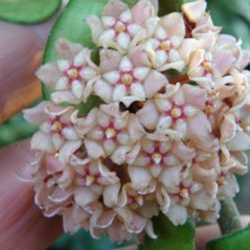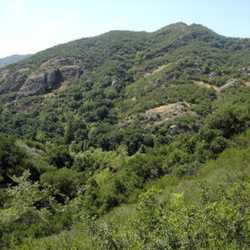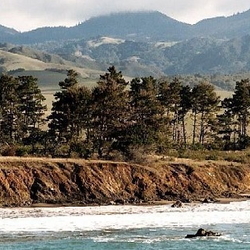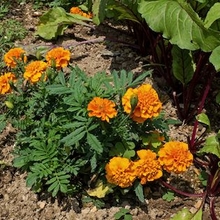(Editor's Note: This article was originally published on May 14, 2009. Your comments are welcome, but please be aware that authors of previously published articles may not be able to promptly respond to new questions or comments.)
Dudleya is a large genus of about 40 species, many of which are native to California and northern Mexico. Only a handful are common in cultivation and many are on the endangered species list. A few can only be found on some of the islands off the California coast.
At one time Dudleyas were included in the Echeveria genus, and one can certainly see why as some species are a bit hard to tell from Echeverias. All Dudleyas are rosette-forming succulents, like the Echeverias, and many are similarly colored. Most Dudleyas are silvery grey, have very delicate leaves that are either flattened or tubular and tend to form stems over time. Most of the flat, thick-leaved forms grow as solitary rosettes while the tubular-leaved species form dense, suckering colonies. The flowers differ somewhat from Echeveria flowers and that is probably the primary reason they are in their own genus now. Dudleya flowers arise from somewhere near the bottom of the rosettes normally (rarely from the rosette center as most Echeveria flowers do). Also, Dudleya flowers are characteristically covered with leaves that are spread out along the peduncle up to the flower, another non-Echeveria-like trait. Most Dudleyas flower in late winter to early spring, and flower colors range from white, to yellow to bright red.



a few Echeverias from my yard: Echeveria colorata, 'Black Prince' and 'Imbricata' (below)


Echeveria-like Dudleya cymosa (photo Ally_UT) non-Echeveria-like Dudleya densiflora


Dudleya sp. that has some Echeveria-like qualities (left or above). Dudleya sp. in my yard showing exposed stem (some Echeverias next to them)- right or below
In general these are long-lived plants; with proper care they can survive up to 100 years (hence their common name: Live-Forever). Dudleyas are wonderfully adapted to the southern California climate, which is wet in winter and dry in summer (generally the opposite of how Echeverias prefer things, but Echeverias are obviously quite hardy and most do well in southern California anyway). In other words, Dudleyas are winter growers, often being dormant in summers. In fact, watering some Dudleyas in the summer can simply kill them, allowing them to rot from overgrowth of Alternaria (a fungus). Some species do not have roots that are able to absorb moisture well in the high heat, so water simply rots the roots. Additionally Dudleyas can rot from the crown, or rosette on down, particularly if water is left sitting on the delicate leaves (some are more sensitive than others). For this reason the general recommendation when watering Dudleyas is to either avoid getting water on the leaves, or plant them at angles so the water runs off. In nature, many species grow naturally on cliff faces and steep slopes so water cannot sit on these plants.
Dudleyas grow well in pots and make excellent outdoor specimens in Mediterranean climates. They can be tough to grow indoors as low-light situations are stressful for them and make them etiolate and prone to mealybug infestation and rot. Potting soil should be very well-draining; many growers amend available soils with sharp sand and pumice to insure good drainage.
 This Dudleya virens in a plant show is perfectly happy as a potted plant
This Dudleya virens in a plant show is perfectly happy as a potted plant
Primary health problems include mealybug infestations, particularly on shade-grown plants, fungal rot (especially on improperly watered plants in hot weather) and snail and slug predation (my personal garden nemeses). Weather extremes are also problems, particularly the farther one grows these from the coast. Blistering summer heat and freezing temperatures are very hard on most Dudleyas, though some species are native to more inland locales, and these ones are well adapted to these more extreme climates. But it is mostly summer heat that makes these plants look less than ornamental all year round. The good thing is they, for the most part, seem to tolerate looking like they're going to die, and rebound as soon as the winter rains start.
The following is an incomplete list of Dudleyas, but ones which I have photos or access to photos of:
Dudleya abramsii: The common name for this southern California and Baja native is Abram's Liveforever (Liveforever is a common name for many species of Dudleya). This is a very small, pale plant that doesn't look like much, even in good times of the year. So of course this is not one of the more popular species in cultivation.

Dudleya abramsii blooming in June in a botanical garden in Southern California
Dudleya albiflora: This is a small, pale-leaved species from Baja California that is also quite rare in cultivation
 plant growing in Santa Barbara Botanical Gardens
plant growing in Santa Barbara Botanical Gardens
Dudleya anomala: this is yet another rarely grown species from Baja California that tends to form low-growing colonies (only several inches tall) of closely packed, tubular, pale green-leaved plants.
 another Santa Barbara Botanical gardens plant
another Santa Barbara Botanical gardens plant
Dudleya attenuata: this native to southern California and Baja, though still pretty rare in cultivation, is at least available now and then. It is another tubular, pale-leaved species that grows in tight clumps.


Dudleya attenuata in the ground in early summer, southern California (left) and in cultivation (right) (right photo Xenomorf)
Dudleya anthonyi: I have a seedling of this Mexican species (Baja California) and it is a nice-looking plant with red flowers. Older plants get large and chalky white and a solitary with wide-leaf rosettes, making them difficult sometimes to distinguish from Dudleya brittonii. So far that is not a problem in my garden.


Dudleya anthonyi in my yard looking a bit green (lack of direct sun all day)- left; more typical plant from Santa Barabra Botanical Gardens on right
 Dudleya anthonyi flowers on my plant in spring
Dudleya anthonyi flowers on my plant in spring
Dudleya brittonii: In my opinion, this is the best of all the Dudleyas, with its nearly pure white leaves and large rosettes (note- there are bright green forms as well, but these are less popular in the nursery trade). It is both an excellent garden as well as pot specimen plant. This plant eventually grows a stem up to two feet tall thickly covered with a skirt made of hundreds of old dead leaves. Flowers are a bright yellow though the pink-red flower stems are even more spectacular than the flowers themselves. Old plants often have many dozens of dried old flower stalks radiating from the living rosette. This is nearly always a solitary species. Dudleya brittonii is another Baja California species.



Dudleya brittoniis in the landscape in Southern California


show plant showing nice white coloration (left) maturing outdoor plant (right)


very old potted plant with about an 18" stem (left); green form of Dudleya brittonii (right)
Dudleya caespitosa (aka Sand Lettuce, Bluff Lettuce or Coastal Dudleya): This is a thick-leaved suckering species from coastal California, including some of the islands off the southern coast. Flowers are pale to bright yellow and leaves are a chalky blue-white, to a pale green, and even sometimes reddish in severe stress.



Dudleya caespitosa in the landscape... note variation in color


Dudleya caespitosa in my yard

unusual form of Dudleya caespitosa (and gorgeous) called Frank Reinelt
Dudleya campanulata: this is a rare species native to coastal Baja and an island or two off its coast. It is a small, pale-leaved species that grows in sparse clumps
 Santa Barbara Botanical Garden plant in summer
Santa Barbara Botanical Garden plant in summer
Dudleya candelabrum: aka Candleholder Live-forever, this is another rarely grown species native to the northern Channel Islans off of south-central California. It is a slow-growing light green, flat-leaved plant with candleabra-like flowers (flower shape not really unique among Dudleyas, though).
 Santa Barbara Botanical Garden plant
Santa Barbara Botanical Garden plant
Dudleya cultrata: very rare species from Baja and images for this vary quite a bit on the internet. Plants I have seen a small, pale green colonies, but some photos show a large, whitish plant on a stalk. Below is a photo from the Botanical Gardens in Santa Barbara

Dudleya cymosa: this plant, called Canyon Live-forever, is a native to central and northern coastal California, as well as southern Oregon. It is a highly variable species. Most plants are somewhat solitary and have short, triangualr flat leaves.


Dudleya cymosa in the wild (San Francisco area) left photo by promethean_spar; Right is different looking plant in cultivation (photo by Ally_UT)
Dudleya densiflora: this is an extremely rare and endangered species, native to right near where I live in Southern California. It's common name is the San Gabriel Mountains Live-forever. It is a somewhat solitary plant with long, tubular leaves that can sometimes curve and look somewhat snake-like.


Dudleya densiflora and flower close up from Santa Barbara Botanical Gardens in early summer


Dudleya densiflora photos from botanical gardens, southern California
Dudleya edulis (aka Fingertips Live-forever): This is not common in cultivation and it is not a particularly attractive plant. However, I have one and it looks nice with its rubbery, tubular pale-green leaves growing out of the red lava rock in the front yard. It is a densely suckering species. Flowers are yellow. Dudleya edulis are native to coastal California down to northern Baja California.


My Dudleya edulis in winter, flowering in late spring


My own plant in early fall in blistering heat showing how bad Dudleyas can look the wrong time of year- this is NORMAL, though! (left); right shows Dudleya edulis in all its flowering glory in Santa Barbara Botanical gardens in early summer (perfect climate for these plants)
Dudleya formosa: this is a relatively newly described species from Baja California that is a small-growing, dull-green, flat-leaved species then tends to form very low-growing colonies.


Dudleya farinosa colony and flowers, early summer, southern California
Dudleya gnoma: this is one of my favorite species- it is one of the most diminutive of the Dudleyas and forms very ornamental clumps of tiny white rosettes. It's common name is aptly Munchkin Live-forever. The plant, Dudleya 'White Sprite' is possibly the same thing (sure looks the same to me). This is another native to Southern California.


Dudleya 'White Sprite' in Santa Barbara Botanical Gardens (left or above); my blooming Dudleya gnoma (right or below) in spring
Dudleya greenii: Some consider Dudleya greenii to be a synonym of Dudleya gnoma, but I list it here separately since it is not clear to me, and the plants to look different (these ones are green and much larger than D gnoma). This plant is native to southern California around the Santa Barbara area (which is where the photo below was taken)

Dudleya guadalupensis: This is a Mexican (Baja California and Guadalupe Island) species and one of the greener Dudleyas. It suckers but has fairly flattened leaves. Flowers are pale to bright yellow.


Dudleya guadalupensis in southern Californnia
 Dudleya guadalupensis in plant show
Dudleya guadalupensis in plant show
Dudleya ingens: This plant, sometimes called the Baja Live-forever, is a questionable plant and could be some interediate hybrid or form of another species. But until that is cleared up, it is found as Dudleya ingens in several botanical gardens. It is a solitary pale-green-leaved plant with lanceolote leaves, somewhat similar to Dudleya lanceolata (only from a different area of California)


Dudleya ingens and flower, southern California
Dudleya lanceolata: The Lanceleaf Live-forever is a native of southern California and Baja, too. It is a solitary species with very fleshy, tender, lance-like, dull-green leaves (a snail's delight).


Dudleya lanceolata in cultivation (left) and in the wild (right photo by Kelli)
Dudleya pachyphytum : aka Cedros Island Live-forever is a native of that island off the coast of Baja California. This is one of the most sought after and over collected species of all the Dudleyas thanks to its wonderful, fat chalkly leaves and ornamental appeal. It is one of the few Dudleyas that may rival Dudleya brittonii for the most striking and ornamental of the Dudleya species. However, it is a delicate species, used to growing in fog-bathed cliffs where the temperatures do not vary that much. Trying to grow this outdoors in Southern California, particularly in inland, hotter climates may not always be met with success, and plants look sad, pale and not-so ormanmental, at least in summers.


plants in cultivation in southern California (in plant shows)


Dudleya pachyphytum as protected, cultivated plant (left) and outdoors in summer in southern California (right)
Dudleya palmeri: Palmer's Live-forever is a native of south-central California around Santa Barbara and San Luis Obispo, found along the coast and cliffs. It has striking tall inflorescences with deep red to bright yellow flowers in late spring to early summer. Even its beefy midsummer inflorescences are covered wtih a dense powdery layer.


Dudleya palmeri photos from the Santa Barbara Botanical gardens in summer
Dudleya pulverulenta (aka Chalk Dudleya): at first glance it can be hard to tell this large, solitary species from Dudleya brittonii if plants are immature as it, too, has a very chalky, almost white dusting on its wide, pointed leaves. However, it has much thinner leaves and really crinkles up in the hot weather, while Dudleya brittonii looks pretty great all year round. This plant is commonly seen along the cliff faces in southern California, even inland to some degree. This is one of the most popular species of Dudleya and is quite commonly available in cultivation.

 Dudleya pulverulentas in botanical gardens
Dudleya pulverulentas in botanical gardens

 Dudleya pulverulenta in nature, and in nursery for sale
Dudleya pulverulenta in nature, and in nursery for sale
Dudleya traskiae: This endangered southern California species is called the Santa Barbara Live-forever and is native to Santa Barbara Island, one of the Channel Islands off its coast. It is a solitary to closely suckering species with flattish, pale blue to chalky green leaves.
 Dudleya traskiae for sale in Southern California
Dudleya traskiae for sale in Southern California
Dudleya virens: this is another aggressively suckering species with green to chalky- blue fingers and pale yellow flowers. There are three distinct subspecies of this plant, all native to the islands off of southern California. I have this in my garden and it's a very easy plant, and though it looks sad in full sun summer heat, it tends to deal with it better than most other species.


Dudley virens subspecies hassei in southern California


Dudleya virens ssp hassei in my garden (left or above) and in Botanical Garden (right or below)


Dudleya virens ssp insularis (left or above) and Dudleya virens ssp virens (right or below)
Dudleya viscida: this species is a San Diego and inland native who's common name is the Sticky Live-forever. I don't find its leaves particularly sticky, but perhaps it is at other times of the year. This is a densely growing colony forming species with thin, tubular leaves.
 in Santa Barbara county botanical gardens
in Santa Barbara county botanical gardens
Dudleya x semiteres: this is a natural occuring hybrid of Dudleya attenuata and either brittonii or candida and has excellent ornamental appeal, having a lot of red-pink leaf coloration at certain times of the year (hotter and drier).
 Santa Barbara botanical gardens, early summer
Santa Barbara botanical gardens, early summer

















